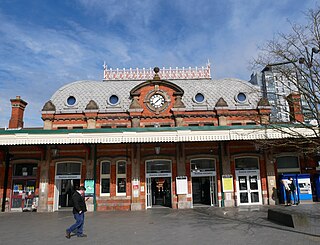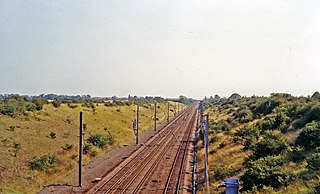
The Quintinshill rail disaster was a multi-train rail crash which occurred on 22 May 1915 outside the Quintinshill signal box near Gretna Green in Dumfriesshire, Scotland. It resulted in the deaths of over 200 people and remains the worst rail disaster in British history.

The Colwich rail crash occurred on the evening of Friday 19 September 1986 at Colwich Junction, Staffordshire, England. It was significant in that it was a high-speed collision between two packed express trains. One driver was killed, but no passengers died because of the great strength of the rolling stock involved, which included Mk1, Mk2 and Mk3 coaches.

Slough railway station, in Slough, Berkshire, England, is on the Great Western Main Line, halfway between London Paddington and Reading. It is 18 miles 36 chains down the line from the zero point at Paddington and is situated between Langley to the east and Burnham to the west. The station is just to the north of the town centre, on the north side of the A4.

Forest Gate railway station is on the Great Eastern Main Line serving Forest Gate in the London Borough of Newham, east London. It is 5 miles 21 chains (8.5 km) down the line from London Liverpool Street and is situated between Maryland and Manor Park. Its three-letter station code is FOG and it is in fare zone 3.

A passing loop or passing siding is a place on a single line railway or tramway, often located at or near a station, where trains or trams travelling in opposite directions can pass each other. Trains/trams going in the same direction can also overtake, provided that the signalling arrangement allows it. A passing loop is double-ended and connected to the main track at both ends, though a dead end siding known as a refuge siding, which is much less convenient, can be used. A similar arrangement is used on the gauntlet track of cable railways and funiculars, and in passing places on single-track roads.
The Norton Fitzwarren rail crash occurred on 4 November 1940 between Taunton and Norton Fitzwarren in the English county of Somerset, when the driver of a train misunderstood the signalling and track layout, causing him to drive the train through a set of points and off the rails at approximately 40 miles per hour (64 km/h). 27 people were killed. The locomotive involved was GWR King Class GWR 6028 King Class King George VI which was subsequently repaired and returned to service. A previous significant accident occurred here on 10 November 1890 and the Taunton train fire of 1978 was also within 2 metres.

The Charfield railway disaster was a fatal train crash which occurred on 13 October 1928 in the village of Charfield in the English county of Gloucestershire. The London, Midland and Scottish Railway (LMS) Leeds to Bristol night mail train failed to stop at the signals protecting the down refuge siding at Charfield railway station. The weather was misty, but there was not a sufficiently thick fog for the signalman at Charfield to employ fog signalmen. A freight train was in the process of being shunted from the down main line to the siding, and another train of empty goods wagons was passing through the station from the Bristol (up) direction.

Brentwood railway station is on the Great Eastern Main Line in the East of England, serving the Essex town of Brentwood. It is 18 miles 16 chains (29.3 km) down the line from London Liverpool Street and is situated between Harold Wood and Shenfield. Its three-letter station code is BRE.

The Harrow and Wealdstone rail crash was a three-train collision at Harrow and Wealdstone station in Wealdstone, Middlesex during the morning rush hour of 8 October 1952. The crash resulted in 112 deaths and 340 injuries, 88 of these being detained in hospital. It remains the worst peacetime rail crash in British history and the second deadliest overall after the Quintinshill rail disaster of 1915.

Over the latter years of the 19th and early years of the 20th centuries, Penistone in Yorkshire gained a name as an accident black-spot on Britain's railway network; indeed, it could be said to hold the title of the worst accident black-spot in the country. The main line through the town was the Woodhead route of the Manchester, Sheffield and Lincolnshire Railway between Sheffield Victoria and Manchester, London Road. The line was heavily graded with a summit some 400 yards inside the eastern portal of the Woodhead tunnel.

Torquay railway station is on the Riviera Line and serves the seaside resort of Torquay, Devon, England. It is 219 miles 79 chains (354 km) from London Paddington.

Hall Road railway station serves Blundellsands in Merseyside, England. The station is located on the Southport branch of the Merseyrail network's Northern Line. Hall Road TMD was adjacent to the station, but this closed in 1997 and has since been demolished.
Two rail accidents have occurred near Castlecary, Scotland. One of these was in 1937 and one in 1968. Both events involved rear-end collisions, and caused the deaths of 35 and 2 people respectively.

The Abbots Ripton rail disaster occurred on 21 January 1876 at Abbots Ripton, then in the county of Huntingdonshire, England, on the Great Northern Railway main line, previously thought to be exemplary for railway safety. In the accident, the Special Scotch Express train from Edinburgh to London was involved in a collision, during a blizzard, with a coal train. An express travelling in the other direction then ran into the wreckage. The initial accident was caused by:

The 1984 Eccles rail crash occurred on 4 December 1984 at Eccles, Greater Manchester, when an express passenger train collided at speed with the rear of a freight train of oil tankers. The driver of the express and two passengers were killed, and 68 people were injured. The cause of the accident was determined to be that the driver of the express train had passed a signal at danger.
The Wrawby Junction rail crash was a train crash which occurred on 9 December 1983, at Wrawby Junction, near Barnetby station, North Lincolnshire, England.
The Kirtlebridge rail crash took place in 1872 at Kirtlebridge railway station in Dumfriesshire. An express passenger train ran into a goods train that was shunting; 11 people lost their lives immediately, and one further person succumbed later. The cause was a failure to communicate between the station master in charge of the shunting operation, and the signalman. There was not full interlocking of the points, and the block system of signalling was not in use.
The Burscough Junction Station Crash occurred on 15 January 1880 at the Burscough Junction railway station on the Liverpool to Preston railway line in England. The line was operated by the Lancashire and Yorkshire Railway company at the time. There were nine people killed in the accident and more than fifty people were injured.
The Tamworth rail crash was an accident that happened at Tamworth railway station in Staffordshire, England, on 14 September 1870. It was caused when a signalman's error accidentally diverted the Irish Mail express onto a dead end siding, where part of the train crashed through the buffers and into the River Anker. Three people were killed, and thirteen injured.

On 26 December 1962, two trains collided near Coppenhall Junction, United Kingdom, killing 18 people and injuring 34. On that evening, cold weather and snow in and around Crewe had caused points to become frozen and trains were being detained at signals. About midway between Winsford and Crewe, the 13:30 Glasgow Central to London Euston Mid-Day Scot, hauled by an English Electric type 4 diesel, D215, with 13 coaches and 500 passengers, was stopped at a signal but the driver found the telephone to Coppenhall Junction, the next signal box ahead, out of order. Seeing the next signal ahead he decided to proceed down towards it and use the telephone there, but too fast. In the darkness he failed to notice the 16:45 express from Liverpool Lime Street to Birmingham New Street, hauled by an electric locomotive with eight coaches with 300 passengers, standing on the line ahead and collided with it at about 20 mph (32 km/h).














